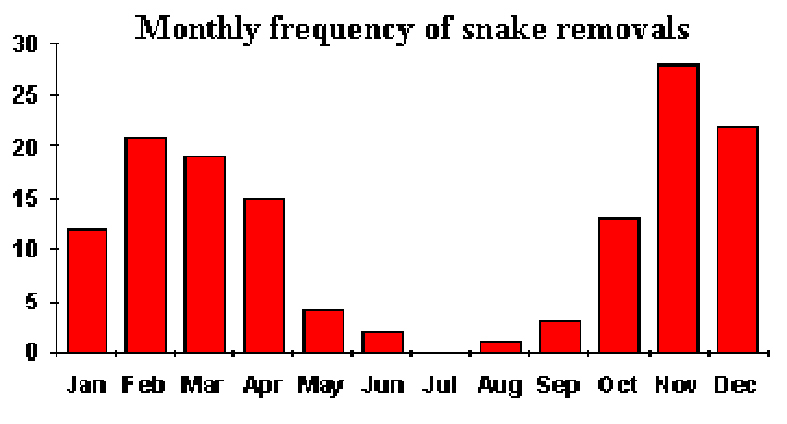Snakes Harmful and HarmlessTM
Snake Removal from Private Property in the Perth Metropolitan area of Western Australia
Prepared by BRIAN BUSH, 9 Birch Place, Stoneville WA 6081, for the Department of Conservation and Land Management (CALM) in June 1995.
INTRODUCTION
Snakes are an integral part of the Australian bush with 112 species being known at this time from Western Australia. Twenty four occur in the Perth metropolitan area, of which 19 are technically venomous, 9 dangerously so to humans. Four of these are sea snakes and are of little concern here as they are unlikely to be found in a backyard situation. Only 2 of the 5 large venomous land snakes found locally are common, ie Dugite (Pseudonaja affinis) and Tiger Snake (Notechis scutatus).
The highest incidence of snakebite in humans is a result of the victim treading on a snake. The second highest incidence is during attempts to kill snakes (Bush, 1995). The Dugite is an especially mobile snake that will forage widely into backyards and buildings in search of mice. The potential for snakebite is far greater in the backyard. A feeling of security and a reduced awareness of snakes in this environment increases the chance of treading on one that maybe there. Also, if a snake is seen the resident often feels obliged to kill it. The snake removal service, Snake Busters, provides volunteers licensed by CALM to remove pest snakes. These volunteers are generally proficient in the safe handling of venomous snakes. They require an endorsement from a person recognised by CALM as a specialised live snake catcher prior to being issued with a Regulation 4 licence for this purpose.
The service was set up primarily to reduce the likelihood of accidental snakebite, but also provides 'pest' snakes for research, education, etc. This reduces the pressure on wild populations occupying natural areas by alleviating the need to remove individuals from these.
Volunteers (Snake Busters)
List of volunteer WA SNAKE BUSTERS
Frequency of Assistance
Each volunteer may receive in excess of 50 calls yearly to remove snakes from private/public property. In approximately 40% of these cases the snake has vanished prior to the snake-catcher arriving. Between 15 and 30 snakes may be bagged by a single volunteer each year. Figure 1 shows the monthly frequency based on a single volunteer's records for the 5 year period 1990-1995.
History of Assistance and Accidents
History: Snake Busters was set up in 1987 to provide a volunteer service to the public, and also allow for an increased opportunity to impart positive educational information to those needing the service. Duty CALM personnel, Police Communications, the Poisons Information Service, local shires and their rangers are all provided with a Snake Busters list. This allows a member of the public to access a telephone number of a snake-catcher when required.
Snake-catching is a specialised activity with few people being psychologically suited. Snakes are very aware of their surroundings and have an uncanny ability to detect nervousness in an individual person. This manifests itself in the snake causing a rapid and pronounced behavioural change to defensive readiness. A common comment after a 'pest' snake has been bagged is "I could have done that myself. It looked so easy." It is far better for someone proficient in snake-handling to undertake this chore than someone with a dislike of snakes!
Accidents: In my position as coordinator of Snake Busters and president of the Western Australian Society of Amateur Herpetologists Inc. (WASAH) I am unaware of any serious accidents involving registered snake-catchers responding to snake-removal calls in the past 5 years. The most serious accidents to date involve occasional scratches experienced scrambling beneath bushes.
Supervision by Calm Officers: As a government wildlife authority's resources are limited, it is not feasible to have officers situated in various suburbs waiting by the telephone day and night to respond to snake-removal calls. On occasions wildlife officers have accompanied and assisted snake-catchers. On other occasions a snake-catcher and a wildlife officer have responded to the same call. There have also been occasions where a wildlife officer has had to bag a 'pest' snake because no one else is available, although these occasions are not common. The ability to catch snakes appears to be a natural attribute rather than something that can be taught. Many wildlife officers would prefer not to have to catch snakes.
The Western Australian Society of Amateur Herpetologists, formally recognised by CALM, have at times carried out training on the safe catching of large venomous snakes. However, as mentioned above, not everyone is suited to this.
Footnote: In Oct. '95 snake catcher envenomed in Dongara while removing gwardar, Pseudonaja mengdeni, from district high school and hospitalised in Sir Charles Gardiner Hosp.

Graph showing monthly frequencies of venomous snake-removal compiled over a
five year period for one snake-catcher in the Perth area. A total of 140 snakes
were removed involving 119 Dugites (Pseudonaja affinis), 13 Tiger Snakes
(Notechis scutatus), 2 Death Adders (Acanthophis antarcticus), 2
Gwardars (Pseudonaja mengdeni), 2 Gould's Hooded Snakes (Parasuta
gouldii) and 2 Half-girdled Snakes (Brachyurophis semifasciata).